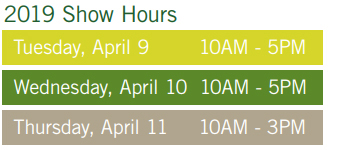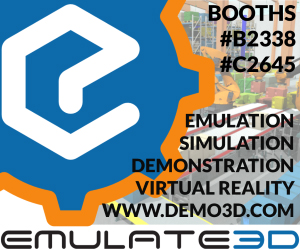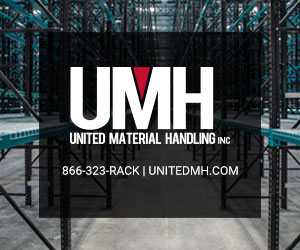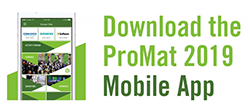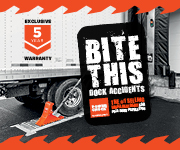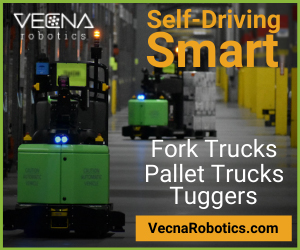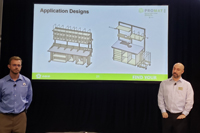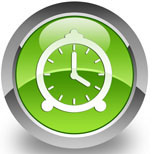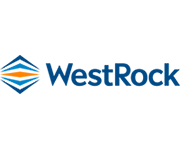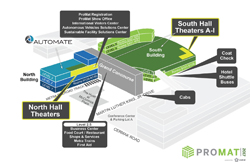 |
||||||||||||||||||||||||||||||||
| Archive | Printer Friendly | Send to a Friend | PROMAT Show | ||||||||||||||||||||||||||||||||
|
Latest Updates
Conference News
Did you know that ProMat 2019 includes collocated sessions of the Chief Robotics Officer (CRO) Summit presented by Robotics Business Review? Conference sessions focus on automation, AI, robotics and the latest intelligent technologies for supply chain operations. See today's session line up under the Daily Schedule, below.
If you pre-registered for ProMat 2019, you should have received your registration confirmation email when you registered. Bring it to a registration kiosk when you arrive at McCormick Place South. If you did not pre-register, proceed to the Registration Counter. Registration is in McCormick Place South on Level 1 and in the Grand Concourse Lobby on Level 3 during the hours of 8:00 AM to 5:00 PM Monday through Wednesday, and 8:00 AM to 2:00 PM on Thursday. Lost badges may be replaced at the Registration Service Desk. Be sure to be on the lookout for the print version of the ProMat 2019 Expo Guide when first hitting the halls. It is also available in digital format.
Take the time to download the ProMat 2019 Mobile App because, trust me, it will not disappoint! With over 1,000 exhibits, four keynotes and over 140 educational sessions at ProMat, you’re going to need a way to stay organized and on-track. Here’s five reasons why the ProMat Mobile App is a must-have tool on-site.
Keynotes, Sessions & Seminars
TUESDAY: 8:45–9:45 AM | Room S100 Best of ProMat Daily
This first gathering of minds at ProMat 2019 was opened by Brett Wood, President of MHI and President & CEO at Toyota Material Handling North America, who set the stage for Harvard Business School’s Karim R. Lakhani with his introduction: “They always say surround yourself with smart people. I am going to be standing next to one in a few minutes!” Lakhani started his presentation with a call for audience participation. It seemed fitting, as it is many of the attendees who will also have to actively participate in the implementation of the presentation’s topic for it to work: blockchain. Lakhani’s asked the audience if they thought blockchain would impact their companies or businesses in the next five year, 10 years or never. Not surprisingly, the five-year mark had the most people raising their hands. “There’s been a ton of hype around blockchain,” explained Lakhami, “even economists are covering it!” As high-tech and new as blockchain and bitcoin are – introduced in October 2008 – “technology keeps coming over and over again, and we can learn from the past,” he said. The concept that blockchain uses is referred to as a ledger. Anything that is happening is part of the ledger, he explained, which can then be opened and distributed across the world. This is one of the greatest pros of blockchain and also one of the biggest fears: “Are all my secrets going to be given away?” This was one of the topics addressed by panelist David Cecchi, Senior Director of Enterprise Data at Cargill Corp. He said the solution is along the lines of posting specific information to the ledger, but not everything. For example, not seeing the specifics of the transaction – such as costs and terms -- but just seeing there was a transaction. Panelist Leanne Kemp, Queensland Chief Entrepreneur & C3PO First, CEO, Founder, Everledger , agreed with the idea of having some data that isn’t shared, and some that is. “Use the chain as a halo-type effect,” she said. Note, however, that the ledger would only consist of what is entered, which prompted a cautionary note: “It doesn’t know the truth,” said Cecchi. What’s shared may be different from the truth. The transparency and traceability of it, however, is already leading to massive changes in some industries, such as food and diamonds. Cecchi said that Cargill now has “turkey traceability.” It allows the end consumer to track a turkey. “There is a code on the turkey. If you type it in, it shows the full provenance on the bird and the farm.” And, Kemp shared some first-hand experiences she’s had in the diamond industry, which has long been paper-trailed and full of verbal contracts and handshakes for much of its business dealings until fairly recently. Now, using the blockchain concept, they are able to trace diamonds. “We have over 2 million diamonds where we created a digital twin,” said Kemp, explaining that diamonds are like snowflakes. The third panelist, Michael J. Reed, Director—Blockchain Program, Intel Corp., emphasized how blockchain is a group effort. “There are a number of ways to get involved outside the four walls of your company. It is a team sport.” Which brings us back to participation. “Blockchain is a distributed network protocol for business transactions,” explained Lakhani. So for it to work, businesses have to participate in researching it, testing it out internally and giving it the opportunity to be a brand new ledger for business activities. It is a project that has the potential to be a game-changer, especialy in material handling.
The Emerging Tech & Sustainability Theater in the North Hall has sessions taking place in a more intimate setting than the Grand Ballroom. Bar-height tables and stools are scattered along the back walls and padded stools are strategically placed close to the presenter for ease of hearing and best visibility. These sessions are free to ProMat attendees and are taking place until the end of the day on Wednesday. Topics cover upcoming technologies, such as drones and fully autonomous inventory counts, as well as sustainable practices, such as reusable packaging. One of the sessions on Monday was on the future of drone delivery and how everyone can benefit from it. Led by Darshan Divakaran, UAS Program Engineer, North Carolina Department of Transportation, Division of Aviation, the discussion focused on how drones (unmanned aircraft systems) are still in the testing phases, but big strides have been made recently related to their use and safety—in fact, as recently as March 26, 2019. when the first routine revenue package delivery flight via drone took place at WakeMed campus in Raleigh, NC, made possible via a partnership between UPS and Matternet as part of North Carolina’s UAS Integration Pilot Program (IPP). Which brings up the question, how and why is the DOT involved in drones? UAS are a form of transportation, so “drones align directly with what we do,” explained Divakaran. North Carolina was chosen as one of ten states to be selected for the IPP program, which got its start in 2018 and it scheduled to run for three years. The goal is to gather “enough data to say it is safe to use drones,” especially as related to beyond the visual line of sight (BVLOS). FAA has only granted 29 BLVOS waivers, 17 of which were given in 2018 and included such companies as Zipline, Matternet, Project Wing and Flirtey. The reason more BVLOS waivers weren’t given? There wasn’t enough data to prove it was safe,” said Divakaran. One area that requires extreme safety measures is shared airspace. “For every manned aircraft there are seven drones,” said Divakaran. “How do we manage the airspace? It is tough.” North Carolina partnered with AirMap, who does somethings similar for air traffic controllers for manned aircraft. They created a UTM dashboard that shows where the drones are. “This was used during Hurricane Florence,” said Divakaran. “Everyone had access to this. In case they had to do manned response, we could bring our aircraft down.” Also, when planning drone flight routes, “we can’t fly just a straight line.” There are zone laws, electric lines, infrastructure, aircraft traffic, weather concerns and densely populated areas to be taken into consideration. Other companies that NC’s IPP has partnered with are Flytrex, TruWeather, Zipline, UPS, WakeMed, Precision Hawk, T-Mobile, Fortem Technologies, UPS and Matternet. Many of these companies have experience in other countries with UAS deliveries, specifically medical package delivery and local package delivery (e.g. food), which are two of the focus points for North Carolina’s research, with infrastructure being the third. Other areas being addressed are weight limits and the who/what/why. Currently Horsefly drones can carry up to 10 pounds, though drones that can carry 500 pounds are being tested by Boeing. And it is very important to know why a drone is flying. A remote ID application called InterUSS is being implemented by Kittyhawk, Wing and AirMap that will be used to identify drones in the sky. Though UAS integration is still very much in the infancy stages when it comes to data and research, the impact they will have on the supply chain once standards are developed and safety measures are established is limitless. North Carolina DOT is hoping their research will help improve, understand, inform and enable safe drone implementation.
In the South Hall, there are more than 100 on-floor seminars taking place over the course of the show. Hear first-hand tips from experts in the industry who are involved in various aspects of the supply chain industry. On Monday, one of the sessions focused on ergonomics in the workplace: Workstations: Basic Steps that Can Improve Productivity and Reduce Operator Injuries. The seminar was led by Jeffrey Hoyle, Director of Ergonomic Services at North Carolina State University – The Ergonomics Center, and Robert Doucette, Application Engineer at BOSTONtec. They talked about how ergonomics can reduce handling, increase speed and improve accuracy. And, when it comes to the workers, “If we are optimizing their wellbeing, then we are optimizing the overall performance,” said Hoyle. Also, it is a matter of fitting the task to the job and getting the right equipment the first time. It is important when it comes to productivity too. “Productivity can be improved by up to 20% with the right ergonomics, said Hoyle, “’and I’ve even seen more.” He said that it also helps with accuracy, comfort and employee morale, and inspectors and insurers expect it. Strains and sprains can be alleviated, as well as other work related musculoskeletal disorders (WMSDs). To make sure you have the correct ergonomics in place, you have to realize that one size does not fit all. As Doucette said, “It may sound basic or obvious, but we have to decide what the station is there for. No operation is the same.” Some of the steps they take into account when planning an ergonomic work station include: Most important when looking at ergonomics? Remember that “It is not a one and done type of thing,” said Doucette. “Document the design, training and flow of the station” and plan on continual reevaluation and improvement. Daily Schedule
These sessions are located in the Emerging Tech & Sustainability Theater and the RoboBusiness Emerging Technologies Theater in the North Hall of McCormick Place. The RoboBusiiness sessions are part of the collocated Chief Robotics Officer Summit. Sessions are free to ProMat attendees. 10:30 AM – 11:00 AM: THE WORKFORCE: DESIGN FOR THEM OR FAIL AT INDUSTRY 4.0
Robotics Officer Summit—RoboBusiness Theater Sessions at North Hall 10:30 AM – 11:15 AM: INTEGRATING DRONES IN LOGISTICS & INVENTORY MANAGEMENT Emerging Tech & Sustainability Sessions at North Hall 11:30 AM – 12:15 PM: ACHIEVING RETURN ON INVESTMENT: DEMYSTIFYING THE HYPE & ACHIEVING IMPLEMENTATION SUCCESS Emerging Tech & Sustainability Sessions at North Hall 12:30 PM – 1:00 PM: SYNCHRONIZING ROBOTICS WITH THE MODERN SUPPLY CHAIN Robotics Officer Summit—RoboBusiness Theater Sessions at North Hall 12:30 PM – 1:15 PM: VISUAL NAVIGATION FOR WHEELED, AUTONOMOUS ROBOTS Emerging Tech & Sustainability Sessions at North Hall 1:15 PM – 1:45 PM: AUTOMATION - THE PRACTICAL CONSIDERATIONS Robotics Officer Summit—RoboBusiness Theater Sessions at North Hall 1:30 PM – 2:15 PM: INTELLIGENT ROBOTS - HOW GRASPING TECHNOLOGY EVOLVED FROM SIMULATION TO THE REAL-WORLD Emerging Tech & Sustainability Sessions at North Hall 2:00 PM – 2:30 PM: THE FUTURE OF MOBILE ROBOTS IN LOGISTICS Robotics Officer Summit—RoboBusiness Theater Sessions at North Hall 2:30 PM – 3:15 PM: LESS IS MORE: SUSTAINABILITY MIGHT BE MORE ABOUT WHAT YOU DON’T USE THAN WHAT YOU DO Emerging Tech & Sustainability Sessions at North Hall 3:00 PM – 3:30 PM: AUTOMATING YOUR INVENTORY MANAGEMENT WITH DRONES SO IT’S 100 TIMES FASTER Robotics Officer Summit—RoboBusiness Theater Sessions at North Hall 3:30 PM – 4:15 PM: RFID: IOT W/ SMARTPHONE ATTACHMENTS INSTEAD OF TERMINALS FOR SHORT/LONG-RANGE HF & UHF/RAIN CYCLE COUNTS, PICKING, & FINDING THE NEEDLE IN A HAYSTACK! Emerging Tech & Sustainability Sessions at North Hall
ProMat Insights
Se where everything will be located at McCormick Place. Also, check out the Show Floor Map, which is interactive and includes the most up-to-date information and the detailed PDF floor plans.
Complimentary shuttle buses will run between McCormick Place South, Level 1, and designated show hotels from April 8-11, 2019. Buses will run on designated routes every 15-20 minutes during the following hours: TUES: 7 AM - 11AM; 3 PM - 7:30 PM
WED: 7 AM - 11 AM; 3 PM - 8 PM THURS: 7 AM - 11 AM; 2 PM - 5 PM Bus schedules will be posted at McCormick Place South and in each hotel. The buses will pick up and drop off on Level 1 of McCormick Place South. |
||||||||||||||||||||||||||||||||

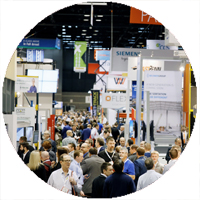 When at ProMat, there are countless ways to expand your knowledge and network. With more than 1,000 exhibits and tens of thousands of attendees, finding solutions and learning about cutting-edge equipment and technology are a given. A new theater debuted this year, as well:
When at ProMat, there are countless ways to expand your knowledge and network. With more than 1,000 exhibits and tens of thousands of attendees, finding solutions and learning about cutting-edge equipment and technology are a given. A new theater debuted this year, as well: 